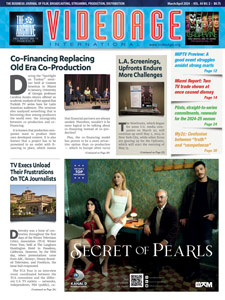For Canadians, their own Upfronts in Toronto start after they return from the L.A. Screenings. Canadians need to be at the Screenings in California since many hot shows are bought and sold outside of small output protections.
At the L.A. Screenings this year there were the three main Canadian buying groups, plus a smaller indie group lead by Channel Zero/ CHCH. The large companies were: Bell (CTV, CTV2, Bell cable channels Space Bravo MuchMusic Discovery, TSN, TMN, HBO Canada, Crave OTT), Corus (Global OTA network, Corus cable channels such as Showcase, History, YTV, WTN, Nick, Lifetime, etc.) and the smallest of the big three: Rogers (Citytv, FX, FXX, etc.). These don’t include French-Quebec buyers, who are considered a different market completely.
The three major TV groups worked furiously to get information on the shows they bought in Hollywood in order to prepare media kits and get the U.S talent ready to go to Toronto. It’s all organized in two weeks and, like in the U.S., billions of ad dollars are spent in Canada during their Upfronts.
Canada’s television business is fighting a digital challenge along with the rest of the world. Digital accounted for $5.4 billion, or 41.9 percent, of all ad spending in Canada last year, according to ad-buying firm GroupM. It’s expected to grow to nearly 47 percent of the market this year. Television drew just under one-quarter of ad spending in Canada last year and that’s expected to decline slightly.
This year, the Canadian Upfronts started on June 6, with Rogers Media at the Metro Toronto Convention Centre, where City unveiled its 2017-18 primetime schedule to approximately 1,200 advertisers, members of the media, influencers and guests.
Events throughout the day gave media and influencers access to executives and talent, including a breakfast for media and executives, exclusive one-on-one interviews with talent, an influencer event and a cocktail event with FX President Eric Schrier. A video presentation and a party closed out the day.
Talent from new City shows were in attendance, too, including Manish Dayal (The Resident), Ed Weeks and Kim Matula (L.A. to Vegas), Diego Klattenhoff (The Blacklist) and Tony Nappo (Bad Blood).
Rogers was followed on June 7 by CTV’s Upfront at the Sony Centre for the Performing Arts, with more than 2,000 attendees on hand. They featured three talent photo opps, which drew major lines from attendees keen on having photos taken with the stars from the fall lineup.
The Corus 2017 Upfront took place June 8. That day began at Corus Quay and included an executive breakfast and presentation of fall programming followed by interviews with talent and execs. The evening featured a dinner and presentation held at Rebel nightclub and hosted by LL Cool J (from Global’s NCIS: Los Angeles).
Other key talent included Anne Heche (Global’s The Brave), Eric McCormack (Global’s Will & Grace and Showcase’s Travelers), Shemar Moore (Global’s S.W.A.T.), Clive Standen (History’s Vikings and Global’s Taken), Caroline Dhavernas (Global’s Mary Kills People), Jermaine Fowler (Global’s Superior Donuts), Mike Vogel (Global’s The Brave), Lucas Till (Global’s MacGyver), Jason Priestley (Global’s Private Eyes) and Cindy Sampson (Global’s Private Eyes).
For Canadian broadcasters, timing is of the essence because the big three don’t know what their schedules will be even though they have their own Upfronts 15 days after Deal Day, which at these L.A. Screenings was midnight of May 21st to the morning of the 22nd. All the U.S. studios had the same Deal Day, and most buyers and sellers stayed at the same hotel or nearby hotels in walking distance, so the deals were done in the hotel rooms.
While there are some output arrangements with the studios, they are not “unlimited.” Some are split between two of the Canadian majors, others have limited volume deals, some don’t include summer series or even midseason series, and some have “pull” rights where the Canadian client can pull a show at a high price to remove it from market bidding.
Some of the output deals allow the studios to shop a show to all bidders, and then require a limited number of unsold shows go to their output clients at a reduced price.
If a studio, as an example, has six new shows to sell, it may have “covers” or the right to push to an output client just three shows. However, other Canadians can bid on any of the six shows, since the studio wants to sell the bad ones with the good ones.
And here is where Canada — a TV market of only 10 million English-speaking homes — makes matters more complex: U.S. studios may not use their output deals if they think a bidding war might result in a higher price than the contract price in their output. A “cover deal” is not a formal output (i.e., all shows from that studio don’t automatically got to their “cover deal” client). Some of these cover deals (a version of an output deal, but lower volume) can give the option for the studio to “push” or force a client to take a show, but does not oblige the studio to do so. Hence, they may have (as an example) six shows to sell in Canada, and a “cover” or right to push three shows to a client, but may not do that, hence the six remaining shows. A studio would not push the three shows to their client if they think a bidding war might result in a higher price, or a situation in which another client wants to buy more volume (i.e., one or two lesser shows as well).
In many parts of the world an “output deal” automatically suggests all shows from that studio go to one client. Increasingly, at least in Canada, there are lower volume “cover” output deals, not true output deals. Why would a client accept the downside of being forced to take X number of shows that they don’t want? Because in return for paying a premium above the cover price they can “pull” or scoop off the market X-number of shows (usually, two or three) at a higher price.
It is unlike some parts of Europe where there is one client for everything at a fixed price. In Canada, a less desirable hour in a poor U.S. network could get C$50,000 per telecast, but a desirable show in a great simulcast time slot could get up to C$250,000 per telecast in a bidding war (second and third runs in a year are available at a big discount). There are huge variations even for studios with some kind of output protection. All Canadian purchases in Hollywood are in Canadian dollars.
Even for Canadians it is hard to explain or understand — it takes a lifetime to figure out how and why CTV or Global or Rogers pays C$250,000 for one show and C$50,000 for another when the lower cost show might do double the ratings in the U.S. — but timeslots and simulcast drive everything.
There is a real marketplace with Canadian bidders, hence the reason for them to be at the L.A. Screenings with all buyers to get what they need, or get more action (i.e. more bidding wars) on bids for popular shows. Because of this competitive content marketplace, old-style 1985 total output deals with one client don’t maximize revenues for most U.S. studios any more in Canada.
SVoD/OTT rights are also a big issue, especially for Crave (run by Bell). Canadians want to be able to move product freely between their own platforms. For example, the new Star Trek series that Bell bought from CBS will probably premiere on the main CTV network in simulcast with CBS, then go to some combination of Space (their sci-fi cable channel) and Crave, their OTT platform, later the same week. Netflix is bidding for just Canadian rights all over the place and protecting their network ratings on first run in a big deal for Global and CTV.
Netflix is a huge factor in Canada. Approximately six million of Canada’s 10 million English TV homes subscribe to Netflix Canada (a very different service and rights than Netflix in the U.S.).
At times, some very urban U.S. sitcoms don’t get sold in Canada and don’t have much of an audience for the U.S. feed. (In Canada, distinctions are made between “urban” sitcoms and “suburban” sitcoms).
Sometimes there is a price disagreement at the L.A. Screenings and the studio won’t sell a show. Modern Family, for example, was unsold in Canada for many months; the studio didn’t like the price, didn’t want to use their “cover” at a low price, and believed in the show. They lost some low license fees in the short term, but six months later when it was doing great numbers in the U.S., Canadian buyers offered much more and Fox sold it in Canada.
Rarely, there is a less desirable small sitcom or sometimes a CW show (CW is a factor in every home in Vancouver via border station, but not in the rest of Canada).
If unsold, then Canadians watch the U.S. feed if they want to see it, from a border station carried on Cable (except for CW) with all the U.S. national and U.S. local commercials.
To be precise, Canadian networks buy the shows, run them across Canada with their own ads sold in them, and it is the cable company (or sat/IPTV company) that makes the ads’ substitution by law. The Canadian networks advise the cable company that they own exclusive Canadian rights to the programs and the law then says if they run it at exactly the same time as the U.S. feeds with exactly the same episode, then cable operators must replace the U.S. feeds with the Canadian feeds. So viewers at home, whether they tune in to the U.S. feeds or the Canadian feeds, are actually watching the Canadian feeds, with those commercials.
This is because only two percent of tuning in in Toronto is over the air via antenna (and that number is even lower in Vancouver and Calgary). But if viewers with good antennas are able to get Buffalo TV from their Toronto homes (some 180 km away), they can watch the U.S. feeds with American commercials.
For Canadian broadcasters, timeslots on U.S. networks are even more important than the quality of the programs. If, for example, CTV already has the hot ABC network show on Thursday at 9 p.m. in simulcast doing well, and NBC has a good new show at the same time, CTV doesn’t want it or need it even if it is a great show.
If, on the other hand, CTV owns the dramas playing on Wednesday night on both ABC and NBC at 9 p.m. in season, CTV can only play one of these two in simulcast at 9 p.m. (simulcast is like syndicated exclusivity in the U.S.). As explained above, by proving to Canadian cable systems that CTV owns exclusive Canadian rights to the 9 p.m. ABC (or NBC) drama, the cable companies must by law pull the plug on the American feed and replace it with the CTV feed running exactly the same episode (with CTV commercials intact).
CTV in this case can charge much higher advertising rates because they are simulcasting out the U.S. feed. (Cable subscribers may try and tune to the U.S.’s ABC or NBC channel, but they actually get the CTV feed with the same drama instead — including CTV commercials). But CTV can only simulcast one U.S. network at a time. So CTV picks the higher revenue program, and then “pre-releases” the other 9 p.m. drama and runs it the night before or even the same night but, let’s say, an hour earlier at 8 p.m. This mitigates CTV “damage,” gets them some revenue, and Canadian viewers, when given a choice to watch their favorite drama on a U.S. or Canadian network, tend to watch it on the network that has it first, either earlier in the evening or even the night before. The pre-release allows the Canadian network to better (though not fully) monetize their high licensee fee. The production studio often allows this pre-release (even if the U.S. client network hates it) because it supports higher license fees in Canada.
VideoAge would like to thank veteran Canadian broadcaster Jay Switzer for explaining the complexity of the Canadian television business model, and to Rogers Media, Bell Media, Corus and Fox Studios for providing photos and/or information.
Audio Version (a DV Works service)












Leave A Comment